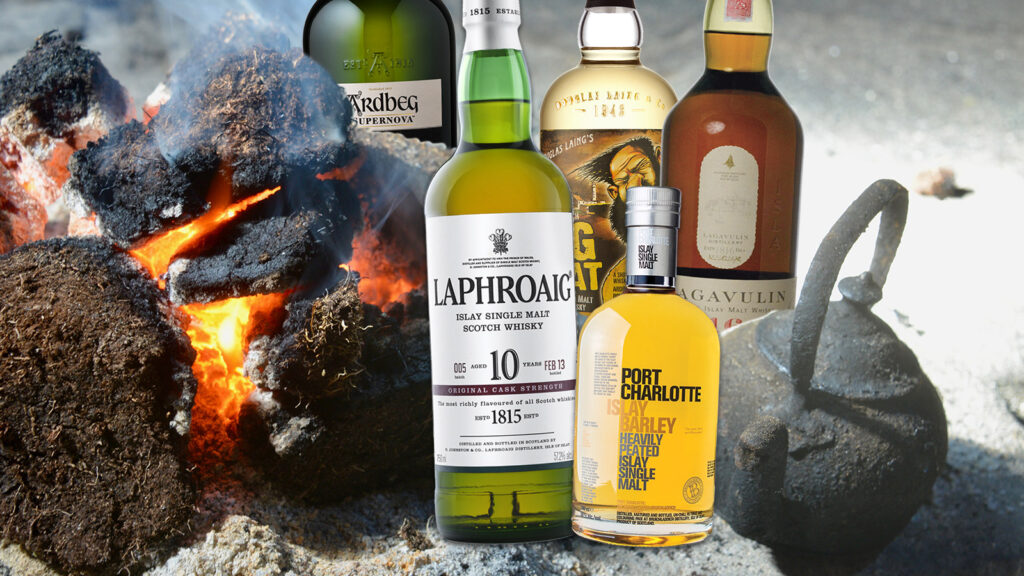
Peated whisky is renowned for its distinctive smoky character, a trait that has captivated whisky enthusiasts for centuries. But how exactly is peated whisky made? From selecting the right barley to mastering the influence of peat smoke, crafting this unique spirit is both an art and a science. Let’s explore the intricate process behind making peated whisky and why it continues to intrigue connoisseurs worldwide.
1. Malting: Where Peat Begins Its Influence
The journey of peated whisky starts with the malting process, where barley is soaked in water to initiate germination. During this phase, enzymes convert starches into fermentable sugars, crucial for alcohol production. Once germination reaches the desired stage, the malt is dried in a kiln.
For peated whisky, this drying process incorporates peat smoke, infusing the barley with phenolic compounds responsible for the whisky’s signature smoky aroma and flavor. The level of smokiness, measured in phenol parts per million (PPM), varies depending on the amount and type of peat used. Islay distilleries, such as Laphroaig and Ardbeg, are famous for their heavily peated expressions, whereas Highland distilleries like Ardmore produce a more subtle smokiness.
2. Mashing and Fermentation: Developing Complexity
Once dried, the malted barley is ground into grist and mixed with hot water in a mash tun to extract sugars. The resulting sugary liquid, or wort, is then cooled and transferred to fermentation tanks, where yeast is introduced. Fermentation typically lasts 48–72 hours, during which yeast converts sugars into alcohol and releases secondary compounds that contribute to the whisky’s complexity.
Some distilleries opt for longer fermentation periods, which can enhance fruitier or floral notes, complementing the dominant smoky profile of peated whisky.
3. Distillation: Refining the Smoky Spirit
The fermented wash is distilled in copper pot stills, traditionally in a two-stage process. The first distillation in the wash still separates alcohol from water and solids, while the second distillation in the spirit still refines the character of the whisky. The distiller makes careful cuts to separate the heart (desired spirit) from the foreshots and feints (undesirable compounds).
Peat influence persists through distillation, but its expression is shaped by the still’s design. Shorter stills with wide necks can result in heavier, oilier spirits, amplifying smokiness, while taller stills encourage lighter, more refined flavors.
4. Maturation: Time, Wood, and Smoke Harmony
Peated whisky gains depth and balance through aging in oak casks, typically for a minimum of three years, though most premium expressions mature for a decade or longer. Cask selection is crucial—ex-bourbon barrels enhance vanilla and caramel notes, while sherry casks introduce dried fruit richness. Over time, the intense smokiness softens, allowing subtle flavors to emerge.
Climate also plays a role. The humid, maritime conditions of Islay contribute to the distinctive briny, medicinal qualities found in whiskies like Lagavulin and Bowmore.
5. Bottling: The Final Peated Expression
Before bottling, peated whisky may be diluted to its desired ABV (alcohol by volume). Some expressions remain cask strength for a more intense experience. Non-chill filtration preserves mouthfeel and complexity, while natural color ensures authenticity.
Why Peated Whisky Stands Out
Peated whisky isn’t just about smoke—it’s about balance, craftsmanship, and regional influence. Whether you prefer a bold, medicinal Islay malt or a gently smoked Highland dram, understanding the production process deepens appreciation for this time-honored spirit.
Are you a fan of peated whisky? Share your favorite expressions with us in the comments below!
Discover more about whisky casks and promotions at whiskybulletin.com.